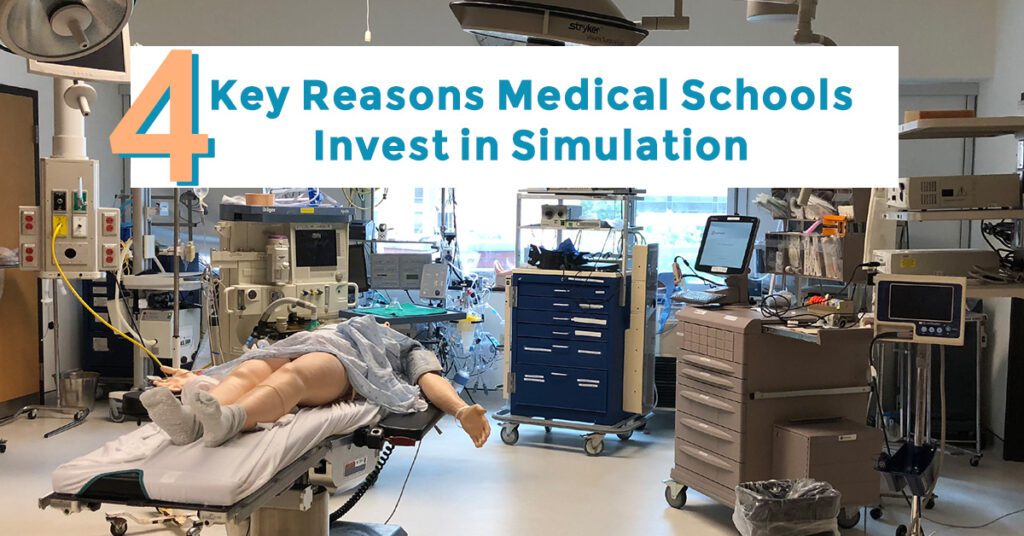Medical educators know their students need to absorb a mountain of knowledge in order for them to become successful practitioners in the real world. Not only do learners need to acquire the requisite knowledge and skills, they also need to be able to apply what they’ve learned in practical but patient-safe ways.
Medical simulation helps solve this problem by providing students with scenarios that simulate real-world situations so they can get used to working with patients and other team members before they begin practicing medicine. But that’s not the only reason why medical schools are increasingly investing in simulation technology. Read on to discover why institutions are trusting medical simulation to secure better educational outcomes that result in tangible, real-world results.
1. Medical simulation gives students a better learning experience.
Medical simulation is a safe opportunity for medical students to practice what they’ve learned by providing them with the opportunity to gain valuable experience without risking harm to actual patients. In addition, with the use of sophisticated scenarios augmented by manikins, virtual reality, or standardized patients, medical simulation has the unique ability to present medical students with complex scenarios that aren’t always “cut and dry.” This type of complex clinical problem solving is excellent practice for future practitioners who wouldn’t otherwise participate in corresponding experiences in a purely didactic learning environment.
This more “realistic” mode of instruction has been proven to have a direct correlation with student performance and learning outcomes. Studies have shown that students who experienced medical simulation in the first two years of their education perform significantly better than those who have not.
2. Simulation teaches medical students how to work as a team.
Teamwork isn’t always an inherent skill for all medical students, but it’s an essential component for success in any healthcare field. Properly executed simulation scenarios, targeted with team-building and intra-team interaction, allow students to practice communicating with each other while making clinical decisions.
This type of simulation gives students the opportunity to practice speaking clearly and concisely when giving instructions, which is essential when you’re trying to simultaneously coordinate co-workers, patients, and others involved in a care scenario.
Teamwork simulation scenarios also provide students with the opportunity to learn how all parts of a care-giving organization fit together. This well-rounded and team-centered knowledge base will allow future practitioners to make informed decisions on how care should be best delivered and by whom.
3. Simulation helps prepare students for difficult clinical situations.
Medical simulation can make a marked difference in students’ soft skills. For example, through the use of standardized patients and high quality debrief sessions, students can learn how to effectively handle situations whereas a doctor they will need to deliver bad news to a patient. Learners can get hands-on experience communicating with patients and their families about the patient’s prognosis in clear, compassionate language that doesn’t sound like medical jargon. The results? Practitioners with attuned soft skills that will help them succeed in real-life situations when they graduate from medical school.
4. Medical simulation encourages students to think about real-world complications.
Clinical decision making won’t be identical for every patient that medical students will face in real-world practice. In a textbook example, the patient has one distinct issue with complications leading to a clear diagnosis. But the reality of clinical practice is that you may encounter patients who have multiple conditions, aren’t forthcoming about their symptoms, or are pregnant, which could complicate diagnosis and treatment plans.
Simulations help students learn how to handle multi-faceted situations they might encounter on the job by first exposing them to a controlled setting. This is especially beneficial for medical school students who may be familiar with individual diagnoses, but lack experience in dealing with patients with multiple issues.
Conclusion
There are many reasons why medical schools are investing in simulation. It allows students to practice skills in a safe environment, it helps them learn the value and benefits of teamwork during patient care, and gives them opportunities to engage in complex or difficult clinical decisions with the benefit of constructive feedback without putting patients’ lives at risk.
With the increasing number of students interested in medicine, it’s important that medical schools provide them with the tools they need to succeed. Medical simulation continues to be a proven method to enhance future practitioners’ skills that will help them throughout their careers.

